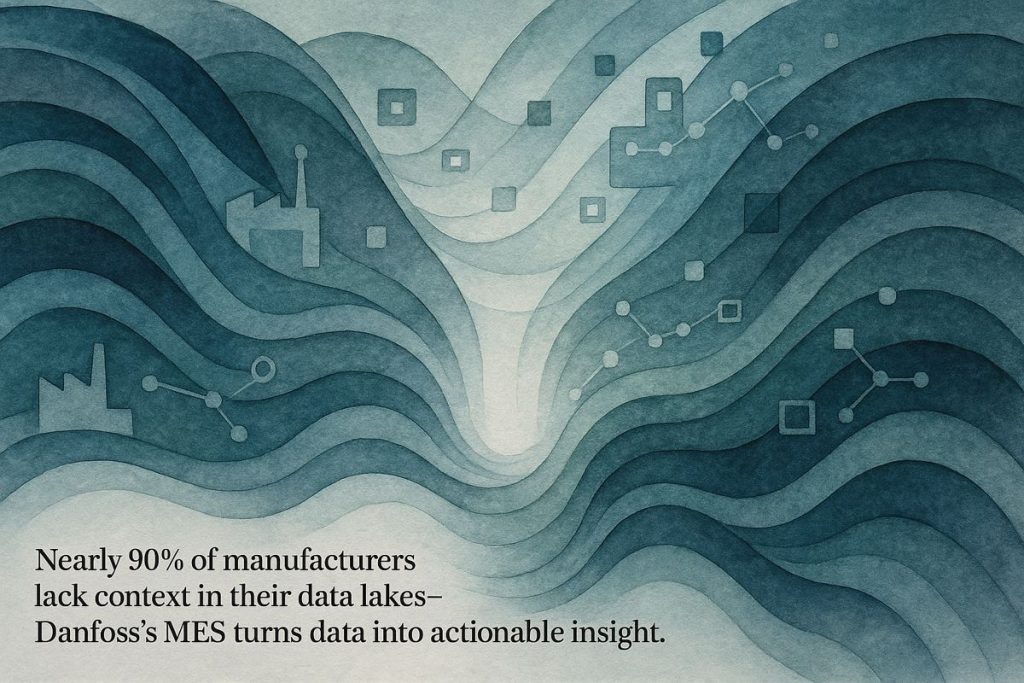Danfoss transformed its factories by uniting old and new tech through a single, smart Manufacturing Execution System (MES), making everything work together smoothly. They didn’t just swap out old machines, but connected them, turning scattered data into useful insights that improved quality, efficiency, and sustainability. Their special way of working, called the Danfoss Business System, helps teams keep getting better every day. By using data wisely, Danfoss cut energy use nearly in half and partnered with tech experts to stay ahead. Their approach proves that thoughtful digital change can make factories both greener and smarter.
What is Danfoss’s approach to digital transformation in manufacturing?
Danfoss’s digital transformation unifies legacy and modern systems across nearly 100 factories using a standardized Manufacturing Execution System (MES). This “context engine” integrates data, enhances process efficiency, boosts product quality, and drives sustainability, all while leveraging the Danfoss Business System and strategic partnerships.
The Origin Story: Digital Disruption (with Good Coffee)
I remember the first time I watched a legacy manufacturing line at Danfoss—one humming conveyor, one ancient PLC, and a smell in the air that was equal parts ozone and nostalgia. Then and there, it struck me: digital transformation isn’t about swapping the old for the new like yesterday’s socks; it’s about weaving old and new into a palimpsest of production, where the past ghosts in the machine are given a new lingua franca. In 2019, Danfoss, the Danish behemoth famed for engineering prowess in power solutions, climate technology, and drives, began its mission to unify the digital nervous system of nearly 100 factories worldwide.
Was it a Herculean task? Absolutely. Some days, the mere thought of integrating legacy Siemens S7 PLCs with spiffy cloud dashboards was enough to make a grown engineer mutter, “Ну, держись…” under his breath. But Danfoss persisted, driven by a vision: to propel operations from analog inertia into the hyperspectral future of Industry 4.0.
Those first steps weren’t exactly a ballet—more of a clumsy waltz involving three core business units and a host of stakeholders, each convinced their processes were the crowning glory. By 2020, consensus (and caffeine) prevailed, and a single digital transformation roadmap began to crystallize. Humming beneath it all: the promise of a standardized Manufacturing Execution System (MES), the kind of backbone every digital gladiator secretly dreams of.
MES as the “Context Engine”: From Data Soup to Digital Caviar
Let me ask: what good is a data lake if you’re drowning in it? I’ve seen companies dump terabytes into “data lakes” and end up with a brackish soup—numbers with neither context nor meaning. Danfoss dodged this pitfall by tapping Siemens Opcenter Execution as its MES platform of choice.
The MES at Danfoss became their context engine. Instead of blind data points, each element—from solder joint temperatures to torque values—was mapped to discrete processes, equipment, and product genealogy. If you’re following the metaphors, what emerged was less a Jackson Pollock splatter and more a Mondrian grid: rigorous, elegant, and with every square in its place. And, as if on cue, the industry began to notice. At confabs like MESI2025, Danfoss showcased how legacy connectivity (without a scorched-earth replacement spree) could power analytics, AI, and real-time optimization on a global scale.
I’ll admit, there was a moment when I doubted whether the old lines in the Drives division would play nice with the new digital choreography. But after seeing a 1987 control module pass inspection while streaming real-time metrics to the MES dashboard, I felt a weird swell of pride—and maybe just a faint whiff of solder flux.
Process Wisdom: The Danfoss Business System (DBS) in Action
At the heart of all this is the Danfoss Business System (DBS), a living document that’s half Kaizen, half Scandinavian pragmatism. Daily shop floor meetings—complete with performance boards and the odd awkward silence—are the crucible where continuous improvement (and the occasional eye-roll) is forged.
DBS leans on the Plan-Do-Check-Act rhythm, a method as old as Deming himself, but here it’s been digitized and scaled. I once watched a new factory, freshly acquired and still smelling of paint, bolt onto this system in under six weeks. There was grumbling, sure, and even a small revolt over barcode label placement, but the outcome was undeniable: soaring productivity, sharper lead times, and, most satisfying of all, fewer late-night fire drills.
The best part? Danfoss didn’t drown in abstraction. They drilled down into specifics: every product that leaves the Drives factory is subjected to reliability testing (they broil and freeze units harder than a polar explorer’s lunch), accelerated life testing, EMC rigors, and—this is my favorite—hundred-percent load testing before shipment. No exceptions. No shortcuts. The resulting quality isn’t so much a promise as it is an inevitability.
Beyond Efficiency: Sustainability and Strategic Foresight
But here’s the kicker: all that digital sweat feeds straight into sustainability. Since 2007, Danfoss has slashed its energy intensity by 45%—not a typo—while nearly doubling output.
And let’s not forget partnerships. Danfoss didn’t go it alone—they joined forces with L&T Technology Services and Critical Manufacturing, each bringing their own brand of domain wizardry to the table. These alliances weren’t just PR stunts; they were strategic, injecting fresh thinking and nimble code into the transformation bloodstream.
A final word on architecture: Danfoss’s modular control ethos means customers only pay for the functionality they need. In some cases, the system is so flexible it can even pinch-hit for a low-end PLC. That’s not just future-proofing, it’s a sort of quiet rebellion against the one-size-fits-all tyranny that plagues so much of industrial automation.
Lessons for the Rest of Us (and One Last Sip)
If I’ve learned anything from watching Danfoss’s journey, Danfoss is marching toward carbon neutrality by 2030, not with grand gestures, but with granular, data-driven discipline.
